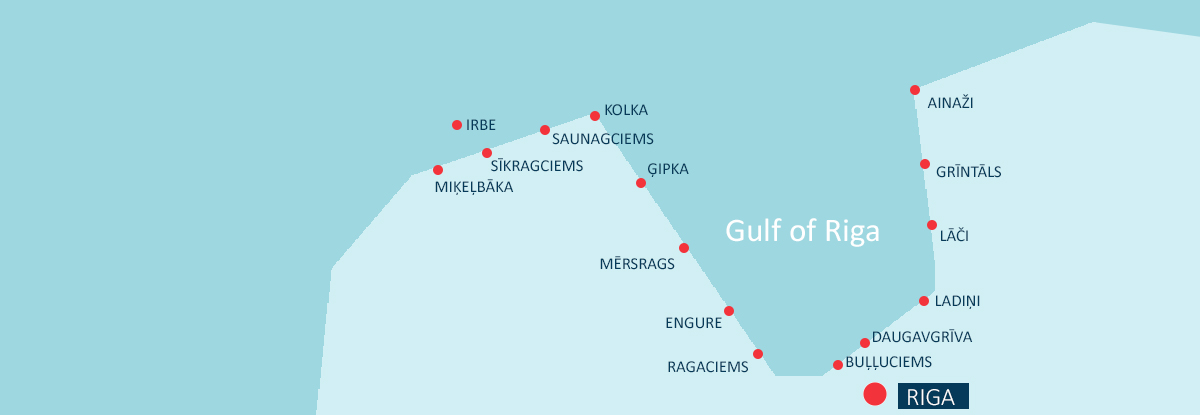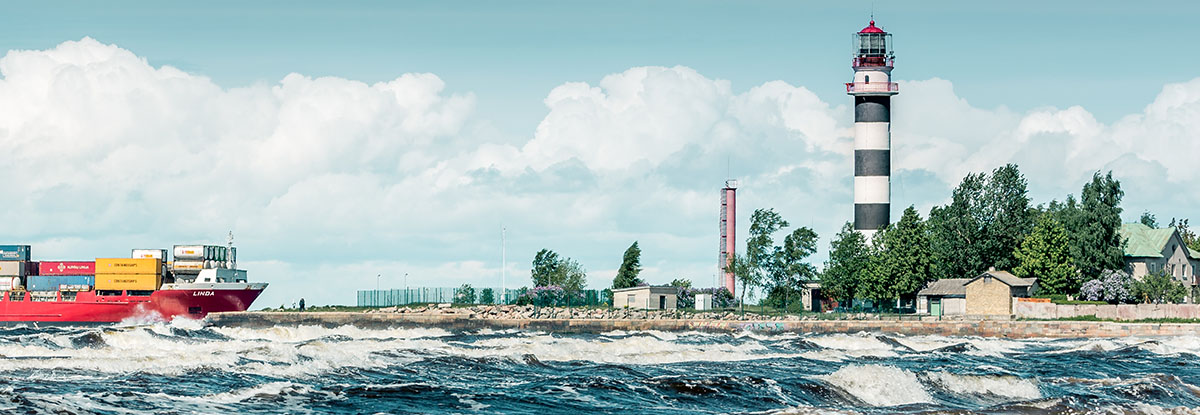The Port Museum

Since 2001, the Freeport of Riga Authority visitors and interested parties have been able to see the exhibition of maritime items, which is located in an improvised training class for navigators. All the exhibited items have been used at the training courses for navigators founded and led by the Ship Master Voldemars Zirings (Voldemārs Zīrings).
For ten years, starting from 1926, Master Zirings, together with associates, has trained more than two hundred boatmasters and specialists, and many of them continued their studies in higher education institutions. Thus a strong group of Latvian seamen and shipowners was founded, providing cargo transshipment under the Latvian flag in practically all the world's seas between the two world wars.
Icebreaker “Varma”
The icebreaker “Varma” was built in Finland in 1968 at Hietalahti shipyard by order of the Finnish National Navigation Administration. The icebreaker successfully navigated in Arctic waters until 1994, when it was purchased by the Latvian Ministry of Transport for 12 million Lats. An icebreaker has been operated by the Riga Port Authority since 1996, breaking ice and escorting vessels through the Gulf of Riga in particularly severe winters and complicated winter navigation conditions.
The icebreaker has been used both as the presidential vessel in Finland by President Urho Kekkonen (1956-1981) and as the ship's parade Commander's vessel, hosting the participants of The Cutty Sark Tall Ships Races in the port of Riga in 2003 and 2013. The icebreaker’s crew has welcomed all the presidents of Latvia, high-ranking foreign officials and military specialists of the allied countries at various events important to Latvia, presenting the Freeport of Riga advantages and promoting Latvia’s maritime traditions.
Lighthouses
There is only one lighthouse in the territory of the Port of Riga - Daugavgrīva lighthouse, still the Freeport of Riga Authority manages 15 lighthouses in the entire coastal area of the Gulf of Riga, including Irbe lighthouse and Miķeļbāka lighthouse, which show the way in the Irbe Strait

Today, lighthouses are not just navigational aids; they have also become a unique cultural and historical heritage of Latvia. The FPRA manages the 65-meter-high Miķeļbāka lighthouse - the highest lighthouse in Latvia, the Kolka lighthouse complex and the Mērsrags lighthouse tower, which are architectural monuments of national significance.
Currently, the Mērsrags lighthouse is open to visitors. For visiting the lighthouse please contact Mērsrags Information Center: +371 632 377 04.
After completing renovation, the Freeport of Riga Authority will evaluate the possibility of opening other lighthouses for tourists and visitors, interested in local history and culture.
Historical sites in the port of Riga
Daugavgrīva lighthouse
Since the 13th century mariners’ vessels have been guided by bonfires at the mouth of the Daugava. A stone layer with a signal fire was installed at the current location of the Daugavgrīva lighthouse by order of King Gustav Adolf of Sweden in 1621, when Swedish troops occupied Riga. In 1788, after the completion of the Western Breakwater construction, the list of lighthouses published by the Tsarist Russia included the wooden log structure in the mouth of the Daugava, which performed the functions of a lighthouse by burning a bonfire on a metal platform at the top of the tower.
During the Crimean War (1853 - 1856), the tower was partially demolished, and its structure was included into the coastal protection system. After the Crimean War in 1863 the tower was renovated by building a stable granite foundation and mounting a cylindrical cast iron structure. It served as a lighthouse until 1915, when it was blown up by Russian troops during the First World War.
In 1920, according to the project of civil engineer E. Weiss, the construction of a reinforced concrete lighthouse was started, and on October 1, 1921, the lighthouse was commissioned. However, during the Second World War on October 9, 1944, when German troops left Riga, the lighthouse was blown up again. In its modern form, the Daugavgrīva lighthouse resumed its work on February 2, 1957.
The height of the Daugavgrīva lighthouse tower is 35 meters, the light device is placed at a height of 30.9 meters and the light visibility from the lighthouse is 15 nautical miles.
Cometfort Dam
One of the most significant cultural and historical sites in the territory of the Freeport of Riga is a protected cultural monument of local significance – the Cometfort Dam in Daugavgrīva. The Cometfort Dam is historically related to cultural monuments of national significance - the building of the Daugavgrīva Fortress, as well as the complex of fortification structures on the banks of the Daugava estuary in Mangaļsala.
Coast fortification structures in Daugavgrīva
In the end of the 19th century and at the beginning of the 20th century engineers of the Russian army began the construction of an ambitious complex of defense structures for military purposes in Daugavgrīva and Mangaļsala, which provided an opportunity to protect access to Riga in case of the enemy attack from the sea. Bastions and cannon platforms, bunkers, observation posts and ammunition depots were built for this purpose. The fortification structure complex included fragments of structures, which had survived from the time of the construction of the Cometfort.
The defensive structures were almost completely destroyed in 1917 with the retreat of the Russian army. During the years of Latvia's independence, the territory was used for the needs of the Latvian army. At the end of the Second World War, with the retreat of the German army, strategically important buildings, including the Daugavgrīva lighthouse, were blown up again. During the USSR era, the territory and the remaining buildings were used for army and civil defense warehouses.
The Eastern Breakwater (Austrumu mols)
The Eastern Breakwater is stretching from Mangaļsala into the sea. The construction of the Eastern Breakwater, built in 1850 - 1861, was closely followed by the Russian Tsar, who visited the site several times. On the bank of the Daugava, near the pier, two stones can be found, which are named "Tsar's stones" in honor of the visit of the Russian Tsar Alexander II and heir to the throne Tsarevich Nicholai.
The Tsar's Stones
In Mangaļsala, near the Eastern Breakwater, on the bank of the Daugava, two stones with historical engravings were placed. On the first stone there is an engraving, commemorating arrival of the Russian Tsar Alexander II at the port of Riga during the breakwater construction on May 27, 1856. The engraving on the second stone tells about the visit of the Tsarevich Nikolai Alexandrovich to the port of Riga on May 4, 1860. The heir to the throne had arrived in Riga to participate in the ceremony of laying a foundation stone of the Riga City Theater (nowadays - the building of the Latvian National Opera and Ballet) and to review the construction of the Eastern Breakwater in the port of Riga.
Western Breakwater (Rietumu mols)
The construction of the Western Breakwater is part and parcel of the Riga port development history. In the middle of the 18th century there was an urgent need to eliminate the clogging of the Daugava estuary, which hindered the entry of vessels into the Daugava and the delivery of goods to the rapidly growing city of Riga. The first records of the breakwater construction, which can be found on maps dating back to 1788, were originally related to the construction of the Cometfort. The Western Breakwater construction began in 1881 and was continued intermittently until 1885, when the breakwater as a hydro structure had the form we can see today.
The Western Breakwater, with the total length of approximately 50 kilometers, is one of the most important hydro structures, regulating the Daugava stream and alluvial system, built with the aim to ensure sustainable operation of the Port of Riga. The breakwater is a structure of piles and fascines, filled with boulders and linked by the concrete covering. Over the years, protective walls and tetrapod stacks, which help the structure to withstand the pressure of water currents and maintain an adequate depth in the shipping channel, were established.
The length of the Western Breakwater is 860 meters, the visible part reaches 3 m at some sections, and the width is up to 5.5 meters. A navigation light and communication structure is installed at the sea end of the breakwater in accordance with navigation safety regulations.
 English
English























